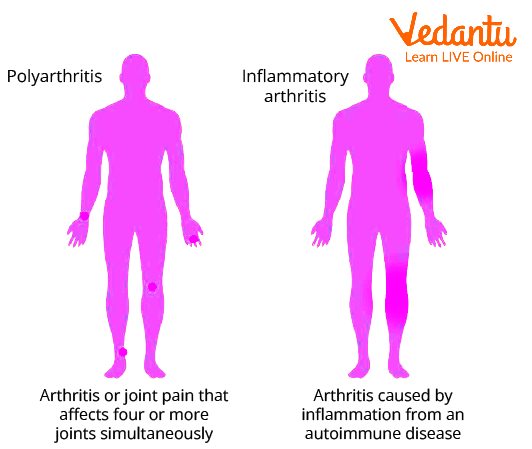What Are the Main Causes and Signs of Polyarthritis?
Arthritis is the swelling and tenderness of one or additional joints. The inflammatory disease could be a general term, derived from the Greek words arthro-, which means “joint,” and -itis, which means “inflammation.” Polyarthritis could be a variety of inflammatory diseases that affect five or additional joints. Joint pain and inflammation are the most common symptoms of one or additional joints. The term describes the number of joints involved: poly suggests several. Polyarthritis could also be chronic or transient (temporary).

Polyarthritis
What is Polyarthritis?
Polyarthritis could be a term used once four or a lot of joints within the body become painful and inflamed. The condition is additionally called polyarthralgia, which suggests “many joint pains.” The name polyarthritis comes from 2 Greek words: “poly,” which means “many, much” and “arthron,” which means “joint”.
Polyarthritis affects as acute episodes or could become chronic, lasting for quite six weeks. Polyarthritis will follow several infectious agents. It's going to evolve into a particular sort of response disease, like atrophic arthritis, lupus, or Sjogren’s syndrome.
Diagnosis of Inflammatory Arthritis
The thought that inflammatory arthritis could occur in childhood was first recommended in 1864 by Cornil. 30 United Nations agencies delineated a 29-year-old girl who had had chronic inflammatory arthritis since the age of twelve. The inflammatory disease could be a grouping of the categories of arthritis involving the system.
It happens most frequently within the hands, wrists, and feet. Symptoms of inflammatory disease aren't localised to the broken joint: patients can also experience fever, weakness, and organ harm additionally with stiffness and pain within the joints. In rare cases, the disease that causes polyarthritis may also cause scarring within the lungs, dry eyes, skin rash, and carditis. Inflammatory diseases like atrophic arthritis, rheumatoid arthritis, autoimmune disease, or autoimmune disorder} is the commonest inflammatory polyarthritis. RA could be a downside to the system.
Diagnosis of RA is completed by a variety of ways or tests performed by doctors for its designation. A number of them include imaging tests like tomography, X-ray, blood tests like complete blood count, blood cell ESR, etc.

Difference Between Polyarthritis and Inflammatory Arthritis
Symptoms of Polyarthritis
Polyarthritis symptoms tend to be like those of arthritis which affect the joints. They'll develop suddenly or over several months. Some of the symptoms include:
Lack of craving
Rash
Sweating
Sore throat (pharyngitis)
Swollen lymph nodes
The temperature of a 104 degrees or more
Unexpected weight loss
fatigue or an absence of energy
In rare cases, the disease that causes polyarthritis may also cause scarring within the lungs, dry eyes, skin rash, and carditis.
Causes and Treatment of Polyarthritis
Causes for Polyarthritis
Polyarthritis will occur because of the results of genetic factors. Some people naturally have disease-destroying proteins in their bodies known as antibodies that build it easier for the condition to thrive.
Polyarthritis causes infections or unwellness, and it will be in the course of another condition. The viruses that cause epidemic roseola and epidemic parotitis conjointly activate the body’s system and may trigger an inflammatory reaction that ends up in somebody developing polyarthritis.
Risk Factors
The risk factors for polyarthritis include:
Family History - Some styles of inflammatory disease run in families. Thus, you will undoubtedly develop the inflammatory disease if your elders or siblings have the disorder.
Age - The danger of the many styles of inflammatory disease — together with degenerative arthritis, autoimmune disease, and gouty arthritis — will increase with age.
Your Sex - Girls have a higher chances than men to develop autoimmune disease, whereas most of those that have gouty arthritis, another form of inflammatory disease, are men.
Previous Joint Injury - Those that have battle-scarred a joint, maybe whereas enjoying a sport, are a bit doubtless to eventually develop the inflammatory disease in this jointPolyarthritis can occur as the result of genetic factors. Some people naturally have disease-destroying proteins in their bodies called antibodies that make it easier for the condition to thrive.
Treatment for Polyarthritis
While polyarthritis can not be cured, nevertheless, it can be treated with medication.
Current healthful polyarthritis’s treatments that are offered include:
Painkillers
Non-steroidal medicinal drug medicine (NSAIDs
Disease-modifying anti-rheumatic medicine (DMARDs)
Methotrexate could be a usually used DMARD that may cut back joint injury caused by polyarthritis.
Biological therapies
Steroids
Interesting Facts
Gout Might be a Type of Arthritis: Perennial flare-ups, pain and swelling are the results of acid, designed round the joints. This might be due to genetic predisposition, some diseases and consumption of excess meat, seafood, fructose-sweetened drinks or alcohol.
Climate Cannot Cure: Individuals have a thought that wet, cold climates cause disease rather than a warmer climate. Sadly, that's not the case. Bioscience confirmed identical frequency for each heat and cold climates. However, sore joints find a hot atmosphere and a lot of soothing.
Important Questions
1. How many joints can polyarthritis have?
2 joints
4 joints
Atleast 5 joints
None of the above
Ans. The correct answer is (c) atleast 5 joints.
Polyarthritis refers to a joint illness that involves a minimum of five joints. One or a lot of signs of inflammation, as well as pain, movement restriction, swelling, warmth, and redness, are seen among the joints concerned.
2. What is reactive polyarthritis?
Ans. Reactive polyarthiritis disease is joint pain and swelling triggered by an infection in another part of the body — most often the intestines, sex organ or urinary tract.
Key Features
Polyarthritis affects five or more joints, both large and small, though typically in a symmetric pattern.
Imaging methods such as ultrasonography and magnetic resonance may be helpful for the diagnosis of arthritis.
The treatment for the disease involves medication or medication-free strategies to reduce pain, promote healing, and allow the joints to continue to work properly.


FAQs on Polyarthritis: Causes, Symptoms, and Treatment in Biology
1. What exactly is polyarthritis?
Polyarthritis is a medical term used to describe a type of arthritis that affects five or more joints simultaneously. It is not a single disease itself but rather a sign or a feature of various underlying conditions. It is characterised by inflammation, pain, and stiffness in the affected joints. This is distinct from monoarthritis (affecting one joint) and oligoarthritis (affecting two to four joints).
2. What are the primary causes of polyarthritis?
The causes of polyarthritis are diverse, but it is most frequently associated with autoimmune disorders where the body's immune system mistakenly attacks healthy joint tissues. The main causes include:
- Rheumatoid Arthritis (RA): The most common cause of inflammatory polyarthritis.
- Psoriatic Arthritis: An autoimmune condition that affects some people with psoriasis.
- Lupus (Systemic Lupus Erythematosus): A systemic autoimmune disease that can affect many parts of the body, including joints.
- Viral Infections: Certain viruses like Parvovirus B19, Ross River virus, and Hepatitis C can trigger a temporary or chronic polyarthritis.
3. What are the common symptoms and warning signs of polyarthritis?
The symptoms of polyarthritis stem from inflammation in multiple joints. Key warning signs to look for include:
- Pain, swelling, and stiffness in five or more joints, often in a symmetrical pattern (e.g., in both wrists or both knees).
- Morning stiffness that lasts for more than 30 minutes.
- A feeling of warmth and redness around the affected joints.
- Chronic fatigue, general malaise, or a low-grade fever.
- Reduced range of motion in the affected joints.
4. What are the main treatment approaches for managing polyarthritis?
Treatment for polyarthritis aims to reduce inflammation, manage pain, and prevent long-term joint damage. The strategy typically involves a combination of approaches:
- Medications: This includes Nonsteroidal Anti-Inflammatory Drugs (NSAIDs) for pain relief, Disease-Modifying Antirheumatic Drugs (DMARDs) like methotrexate to slow disease progression, and Biologics that target specific parts of the immune system.
- Physical Therapy: Exercises to improve joint flexibility, strengthen supporting muscles, and maintain function.
- Lifestyle Adjustments: Maintaining a healthy weight to reduce stress on joints and adopting an anti-inflammatory diet.
5. How is polyarthritis different from polyarthralgia?
The key difference between polyarthritis and polyarthralgia lies in the presence of inflammation. Polyarthralgia simply means 'pain in many joints' (arthr- meaning joint, and -algia meaning pain). In contrast, polyarthritis involves both joint pain and clear signs of inflammation, such as swelling, redness, stiffness, and warmth. A person can have polyarthralgia without inflammation, but polyarthritis always includes inflammation.
6. What is the relationship between polyarthritis and rheumatoid arthritis (RA)?
Polyarthritis is a general description, while rheumatoid arthritis (RA) is a specific disease. Think of it this way:
- Polyarthritis is the condition of having five or more inflamed joints. It is a clinical sign.
- Rheumatoid Arthritis (RA) is a specific autoimmune disease that is a very common cause of chronic, inflammatory polyarthritis.
7. Can diet and lifestyle changes help in managing polyarthritis symptoms?
Yes, diet and lifestyle can play a significant supporting role in managing polyarthritis. While they cannot cure the underlying disease, they can help reduce inflammation and improve overall well-being. An anti-inflammatory diet, rich in omega-3 fatty acids (found in fatty fish), antioxidants (from fruits and vegetables), and whole grains, is often recommended. Conversely, limiting processed foods, sugar, and saturated fats can help avoid triggering more inflammation. Regular, low-impact exercise like swimming or cycling is also crucial for maintaining joint mobility and muscle strength.
8. Can polyarthritis affect organs other than the joints?
Yes, particularly when it is caused by a systemic autoimmune disease like rheumatoid arthritis or lupus. In these conditions, the underlying inflammation is not confined to the joints and can affect other parts of the body. For example, rheumatoid arthritis can lead to issues with the skin (rheumatoid nodules), eyes (dryness), lungs, and heart. This is because the immune system attacks various healthy tissues, not just the synovium (joint lining).










